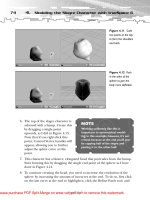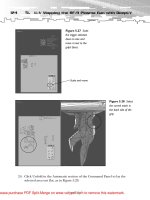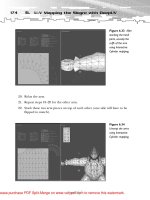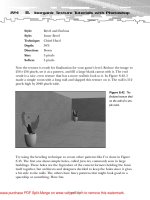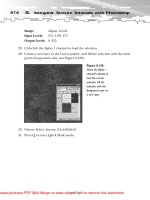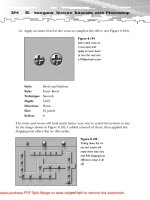Learning three js the javascript 3d library for WebGL
Bạn đang xem bản rút gọn của tài liệu. Xem và tải ngay bản đầy đủ của tài liệu tại đây (12.17 MB, 402 trang )
www.it-ebooks.info
Learning Three.js: The
JavaScript 3D Library for
WebGL
Create and animate stunning 3D graphics using the
open source Three.js JavaScript library
Jos Dirksen
BIRMINGHAM - MUMBAI
www.it-ebooks.info
Learning Three.js: The JavaScript 3D Library
for WebGL
Copyright © 2013 Packt Publishing
All rights reserved. No part of this book may be reproduced, stored in a retrieval
system, or transmitted in any form or by any means, without the prior written
permission of the publisher, except in the case of brief quotations embedded in
critical articles or reviews.
Every effort has been made in the preparation of this book to ensure the accuracy
of the information presented. However, the information contained in this book is
sold without warranty, either express or implied. Neither the author, nor Packt
Publishing, and its dealers and distributors will be held liable for any damages
caused or alleged to be caused directly or indirectly by this book.
Packt Publishing has endeavored to provide trademark information about all of the
companies and products mentioned in this book by the appropriate use of capitals.
However, Packt Publishing cannot guarantee the accuracy of this information.
First published: October 2013
Production Reference: 1101013
Published by Packt Publishing Ltd.
Livery Place
35 Livery Street
Birmingham B3 2PB, UK.
ISBN 978-1-78216-628-3
www.packtpub.com
Cover Image by Asher Wishkerman ()
www.it-ebooks.info
Credits
Author
Project Coordinator
Jos Dirksen
Leena Purkait
Reviewers
Proofreaders
Andrea Barisone
Mario Cecere
Will Crichton
Lawrence A. Herman
Yi-Fan Liao
Indexer
Sebastian Poreba
Mariammal Chettiyar
I. Abiyasa Suhardi
Graphics
Acquisition Editor
Abhinash Sahu
Kevin Colaco
Lead Technical Editor
Arun Nadar
Technical Editors
Anita Nayak
Production Coordinator
Arvindkumar Gupta
Cover Work
Arvindkumar Gupta
Ritika Singh
www.it-ebooks.info
About the Author
Jos Dirksen has worked as a Software Developer and Architect for more than
a decade. He has much experience in a large range of technologies ranging from
backend technologies, such as Java and Scala, to frontend development using
HTML5, CSS, and JavaScript. Besides working with these technologies, Jos also
regularly speaks at conferences and likes to write about new and interesting
technologies on his blog. He also likes to experiment with new technologies
and see how they can best be used to create beautiful data visualizations,
the results of which you can see on his blog at />Jos is currently working as an Enterprise Architect for Malmberg, a large Dutch
publisher of educational material. He is helping to create a new digital platform
for the creation and publishing of educational content for primary, secondary,
and vocational education.
Previously, Jos has worked in many different roles in the private and public sectors,
ranging from private companies such as Philips and ASML to organizations in the
public sector, such as the Department of Defense.
Besides his interest in frontend JavaScript and HTML5 technologies, he is also
interested in backend service development using REST and traditional web service
technologies. Jos has already written two books on this subject. He is the coauthor
of the Open Source ESBs in action book that was published in 2008, and in 2012 he
published a book on how to apply SOA Governance in a practical manner. This
book is titled SOA Governance in Action.
www.it-ebooks.info
Acknowledgement
Writing books is a long and hard effort. I couldn't have done this without the
support and hard work of many others. There are many people I'd like to thank.
First off, my project coordinator Leena Purkait, without whom I would never have
finished all the chapters on time, for coordinating all the details and allowing me to
focus on creating the content. I'd also like to thank Ritika Singh and Anita Nayak for
all the time and effort they spent in finalizing the chapters.
All the other people from Packt Publishing who have helped me during the writing,
reviewing, and laying out process. Great work, guys!
I, of course, have to thank Ricardo Cabello, also known as Mr.dò_ób, for creating the
great Three.js library.
Much thanks go to the reviewers. You provided great feedback and comments that
really helped improve the book. Your positive remarks really helped shape the book!
I haven't mentioned the most important persons yet. I'd like to thank my wife Brigitte,
who once again had to endure me spending my weekends and evenings behind my
laptop, my daughter Sophie for pulling me away from my keyboard and always
making me laugh, and my daughter Amber, who, even though she is just a couple of
weeks old, makes me appreciate the really important things and moments in life.
www.it-ebooks.info
About the Reviewers
Andrea Barisone works for a leading Italian IT company and has over 13 years
of experience in Information Technology, working on corporate projects as a
Developer using different technologies. He has also strong experience in the
ECM Systems, and several J2EE certifications. He has great ability to acquire new
technologies and to exploit the knowledge acquired while working with different
environments and technologies.
Andrea is a Technical Reviewer for Agile Web Development with Rails 4 by
Pragmatic Bookshelf, and also for BPEL and Java Cookbook by Packt Publishing
(work in progress.)
I would like to thank my parents, Renzo and Maria Carla, for the
gift of life they gave me, my beloved wife Barbara, and my two
wonderful little children, Gabriele and Aurora, for making my life
wonderful every day.
Will Crichton has been a Web Developer for many years. He is currently studying
Computer Science at the Carnegie Mellon University. Previously, he has worked
with a web design company, Webspec Design, and a biotechnology company,
Pioneer Hi-Bred. Beyond just work, Will loves creating web applications—many
merely adopted JavaScript, but he was born to it. He has created several frameworks
and applications by using HTML5 technologies and continues to do more every day.
I'd like to thank my brother, Alex, for his excellent guidance as
a brother and programming mentor, as well as my parents for
supporting me throughout my coding endeavors!
www.it-ebooks.info
Yi-Fan Liao is a Frontend Developer who is enthusiastic about exploring the
possibilities of the web. He started programming with .NET for building an
online medicine tutoring application in 2004 and is proficient in web application
design, architecture design, and performance tuning. He has expertise in HTML5
multiplayer game development and extensive experience in JavaScript canvas
animation. Yi-Fan loves widget-making and knowledge-sharing. He was a speaker
for Begin Three.js at JSDC 2013 and is located in Taipei, Taiwan.
Sebastian Poreba is a JavaScript Developer with a game development background.
At work, he uses the Google Closure tool chain for data analysis application. After
hours, he plays with WebGL and physics, and blogs at www.smashinglabs.pl
I. Abiyasa Suhardi is an Indonesian guy living a double life in Berlin, Germany.
His day job is as a Frontend Developer doing Flash/Flex, HTML5, and JavaScript
programming. His passion is working on indie game projects in the evenings,
weekends, or whenever he has free time. He is sort of like Batman, but instead of
saving the city himself, he made his game characters the heroes.
He has a Bachelor's Degree in Informatics Engineering, a Master's Degree in Digital
Media, and 9 years of experience working in the IT world, ranging from C/C++ for
an intranet portal, teaching Macromedia Director, founding a J2ME game company,
RIA Development using Flash/Flex, and mobile development with Android and
Adobe AIR, to JavaScript development for backend and frontend.
Currently, he is working in a startup company, while backing up his partner-in-crime,
his wife, in building their own startup.
You can follow his work at and connect with him on
Twitter (@abiyasasuhardi).
www.it-ebooks.info
www.PacktPub.com
Support files, eBooks, discount offers and more
You might want to visit www.PacktPub.com for support files and downloads related
to your book.
Did you know that Packt offers eBook versions of every book published, with PDF
and ePub files available? You can upgrade to the eBook version at www.PacktPub.com
and as a print book customer, you are entitled to a discount on the eBook copy. Get in
touch with us at for more details.
At www.PacktPub.com, you can also read a collection of free technical articles, sign
up for a range of free newsletters and receive exclusive discounts and offers on Packt
books and eBooks.
TM
Do you need instant solutions to your IT questions? PacktLib is Packt's online
digital book library. Here, you can access, read and search across Packt's entire
library of books.
Why Subscribe?
• Fully searchable across every book published by Packt
• Copy and paste, print and bookmark content
• On demand and accessible via web browser
Free Access for Packt account holders
If you have an account with Packt at www.PacktPub.com, you can use this to access
PacktLib today and view nine entirely free books. Simply use your login credentials
for immediate access.
www.it-ebooks.info
Table of Contents
Preface1
Chapter 1: Creating Your First 3D Scene with Three.js
7
Requirements for using Three.js
Getting the source code
Using Git to clone the repository
Downloading and extracting the archive
Testing the examples
11
12
13
14
14
Creating an HTML skeleton page
Rendering and viewing a 3D object
Adding materials, lights, and shadows
Expanding your first scene with animations
Introducing the requestAnimationFrame() method
Animating the cube
Bouncing the ball
Using the dat.GUI library to make experimenting easier
Using the ASCII effect
Summary
16
19
24
27
27
30
30
32
33
35
Python-based approach should work on most Unix/Mac systems
NPM-based approach if you've got Node.js installed
Portable version of Mongoose for Mac/Windows
Chapter 2: Working with the Basic Components That Make
Up a Three.js Scene
Creating a scene
Basic functionality of the scene
Adding the fog effect to the scene
Using the overrideMaterial property
Working with the Geometry and Mesh objects
The properties and functions of a geometry
www.it-ebooks.info
15
15
15
37
37
38
44
45
46
47
Table of Contents
The functions and attributes for a mesh
Using the available cameras for different uses
The orthographic camera versus the perspective camera
Focusing the camera on a specific point
Summary
Chapter 3: Working with the Different Light Sources
Available in Three.js
Exploring the lights provided by Three.js
Learning about the basic lights
AmbientLight – a globally applied light source
Using the THREE.Color() object
PointLight – the light that shines in all directions
SpotLight – the light with a cone effect
DirectionalLight – for a far away sun-like light source
Using special lights for advanced lighting
52
57
57
62
64
65
66
66
67
69
71
75
80
83
HemisphereLight83
AreaLight84
LensFlare87
Summary
Chapter 4: Working with the Three.js Materials
Understanding the common material properties
Basic properties
Blending properties
Advanced properties
Starting with the simple Mesh materials (basic, depth, and face)
The MeshBasicMaterial for simple surfaces
The MeshDepthMaterial for depth-based coloring
Combining the materials
The MeshNormalMaterial for normal-based colors
The MeshFaceMaterial for assigning a material to each face
Learning about the advanced materials
The MeshLambertMaterial for dull, non-shiny surfaces
The MeshPhongMaterial for shiny objects
Creating your own shaders with the ShaderMaterial
Using the materials for a line geometry
The LineBasicMaterial
The LineDashedMaterial
Summary
[ ii ]
www.it-ebooks.info
91
93
94
94
95
96
97
97
100
102
104
107
110
110
112
114
121
122
124
125
Table of Contents
Chapter 5: Learning to Work with Geometries
The basic geometries provided by Three.js
Two-dimensional geometries
127
128
128
PlaneGeometry128
CircleGeometry130
ShapeGeometry132
Three-dimensional geometries
137
CubeGeometry138
SphereGeometry
139
CylinderGeometry142
TorusGeometry144
TorusKnotGeometry145
PolyhedronGeometry147
Summary
150
Chapter 6: Using Advanced Geometries and Binary Operations
153
Chapter 7: Particles and the Particle System
181
ConvexGeometry
154
LatheGeometry
156
Create a geometry by extruding
158
ExtrudeGeometry158
TubeGeometry
160
Extrude from SVG
162
ParametricGeometry
164
Creating 3D text
167
Rendering text
167
Adding custom fonts
170
Using binary operations to combine meshes
171
The subtract function
173
The intersect function
177
The union function
179
Summary
180
Understanding particles
Particles, the particle system, and the BasicParticleMaterial
Styling particles with the HTML5 canvas
Using HTML5 canvas with the CanvasRenderer class
Using HTML5 canvas with the WebGLRenderer class
Using textures to style particles
Working with sprites
Creating a particle system from an advanced geometry
Summary
[ iii ]
www.it-ebooks.info
182
184
187
188
190
192
199
204
206
Table of Contents
Chapter 8: Creating and Loading Advanced
Meshes and Geometries
Geometry grouping and merging
Grouping objects together
Merging multiple meshes into a single mesh
Loading geometries from external resources
Saving and loading in Three.js JSON format
Saving and loading a geometry
Saving and loading a scene
207
207
208
210
212
213
213
216
Working with Blender
218
Importing from 3D file formats
224
Installing the Three.js exporter in Blender
Loading and exporting a model from Blender
OBJ and MTL format
Loading a collada model
Loading STL, CTM, and VTK models
Showing proteins from the protein databank
Creating a particle system from a PLY model
Summary
Chapter 9: Animations and Moving the Camera
219
221
224
228
229
231
234
235
237
Basic animations
238
Simple animations
238
Selecting objects
240
Animating with Tween.js
242
Working with the camera
245
TrackballControls
246
FlyControls248
RollControls250
FirstPersonControls250
OrbitControl252
PathControl254
Morphing and skeletal animation
257
Animation with morph targets
258
Animation with MorphAnimMesh
Creating an animation by setting the morphTargetInfluence property
Animation using bones and skinning
Creating animations using external models
Creating bones animation using Blender
Loading an animation from a collada model
Animation loaded from a Quake model
Summary
[ iv ]
www.it-ebooks.info
259
262
263
266
266
270
272
274
Table of Contents
Chapter 10: Loading and Working with Textures
Using textures in materials
Loading a texture and applying it to mesh
Using a bump map to create wrinkles
Using more detailed bumps and wrinkles with a normal map
Creating fake shadows using a light map
Creating fake reflections using an environment map
Specular map
Advanced usage of textures
Custom UV mapping
Repeat wrapping
Rendering to canvas and using it as a texture
Using canvas as a texture
Using canvas as a bump map
Using the output from a video as a texture
Summary
Chapter 11: Custom Shaders and Render Post Processing
Setting up the post processing
Creating the EffectComposer object
Configuring the EffectComposer object for post processing
Updating the render loop
Post processing passes
Simple post processing passes
Using the FilmPass to create a TV-like effect
Adding a bloom effect to the scene with the BloomPass
Outputting the scene as a set of dots with the DotScreenPass
Showing the output of multiple renderers on the same screen
Advanced EffectComposer flows by using masks
Using the ShaderPass for custom effects
Simple shaders
Blurring shaders
Advanced shaders
Creating custom post processing shaders
Custom grayscale shader
Creating a custom bit shader
Summary
Chapter 12: Adding Physics to Your Scene with Physijs
Creating a basic Three.js scene ready for Physijs
Material properties
Basic supported shapes
Using constraints to limit movement of objects
Using PointConstraint to limit movement between two points
[v]
www.it-ebooks.info
277
278
278
282
284
286
288
292
294
294
297
299
300
301
303
305
307
308
309
310
310
311
312
313
314
315
317
318
323
324
327
329
330
330
334
336
339
340
346
348
354
355
Table of Contents
Creating door-like constraints with a HingeConstraint
Limiting movement to a single axis with a SliderConstraint
Creating a ball joint-like constraint with the ConeTwist Constraint
Creating detailed control with the DOFConstraint
Summary
357
359
361
364
368
Index371
[ vi ]
www.it-ebooks.info
Preface
In the last couple of years, browsers have gotten more powerful and are capable
platforms to deliver complex applications and graphics. Most of this, though, is
standard 2D graphics. Most modern browsers have adopted WebGL, which allows
you to not only create 2D applications and graphics in the browser, but also create
beautiful and good performing 3D applications, using the capabilities of the GPU.
Programming WebGL directly, however, is very complex. You need to know the
inner details of WebGL and learn a complex shader language to get the most out of
WebGL. The Three.js library provides a very easy-to-use JavaScript API based on the
features of WebGL, so that you can create beautiful 3D graphics, without having to
learn the WebGL details.
The Three.js library provides a large number of features and APIs that you can use
to create 3D scenes directly in your browser. In this book you'll learn all the different
APIs that the Three.js library has to offer through lots of interactive examples and
code samples.
What this book covers
Chapter 1, Creating Your First 3D Scene with Three.js, covers the basic steps that you
need to take to get started with the Three.js library. You'll immediately create your
first Three.js scene and at the end of this chapter, you'll be able to create and animate
your first 3D scene directly in the browser.
Chapter 2, Working with the Basic Components That Make Up a Three.js Scene, explains
the basic components that you need to understand while working with the Three.js
library. You'll learn about lights, meshes, geometries, materials, and cameras. In this
chapter you will also get an overview of the different lights that the Three.js library
provides and the cameras you can use in your scene.
www.it-ebooks.info
Preface
Chapter 3, Working with the Different Light Sources Available in Three.js, dives deeper
into the different lights that you can use in your scene. It shows examples and
explains how to use a SpotLight, DirectionLight, AmbientLight, PointLight,
HemisphereLight, and AreaLight sources. Additionally, it also shows how to
apply a LensFlare effect on your light source.
Chapter 4, Working with the Three.js Materials, talks about the materials available in
the Three.js library that you can use in your meshes. It shows all the properties that
you can set to configure the materials for your specific use and provides interactive
examples to experiment with the materials that are available in the Three.js library.
Chapter 5, Learning to Work with Geometries, is the first of two chapters that explores all
the geometries that are provided by the Three.js library. In this chapter you'll learn
how to create and configure geometries in Three.js and you can experiment by using
the provided interactive examples, with geometries such as plane, circle, shape, cube,
sphere, cylinder, Torus, TorusKnot, and PolyHedron.
Chapter 6, Using Advanced Geometries and Binary Operations, continues where Chapter 5
left off. It shows you how to configure and use the more advanced geometries that are
provided by the Three.js library such as Convex and Lathe. In this chapter you'll also
learn how to extrude 3D geometries from the 2D shapes and how you can create new
geometries by combining geometries using binary operations.
Chapter 7, Particles and the Particle System, explains how to use the particle system
from the Three.js library. You'll learn how to create a particle system from scratch,
and from the existing geometries. In this chapter you'll also learn how you can
modify the way the particles look through the use of sprites and particle materials.
Chapter 8, Creating and Loading Advanced Meshes and Geometries, shows you how to
import meshes and geometries from external sources. You'll learn how to use the
Three.js library internal JSON format in order to save the geometries and scenes. This
chapter also explains how to load models from formats like OBJ, DAE, STL, CTM,
and PLY.
Chapter 9, Animations and Moving the Camera, explores the various types of animations
that you can use to make your scene come to life. You'll learn how to use the Tween.
js library together with Three.js, and you'll learn how to work with the animation
models based on morphs and skeletons.
Chapter 10, Loading and Working with Textures, expands on Chapter 4 where materials
were introduced. In this chapter we will dive into the details of textures. It introduces
the various types of textures that are available and how you can control a texture that
is applied to your mesh. Additionally in this chapter, you are shown how you can
directly use the output from the HTML5 video and canvas elements as input for
your textures.
[2]
www.it-ebooks.info
Preface
Chapter 11, Custom Shaders and Render Post Processing, explores how you can use the
Three.js library to apply the post processing effects to your rendered scene. With post
processing you can apply effects, such as blur, tilt shift, and sepia to your rendered
scene. Besides this, you'll also learn how to create your own post processing effect
and create a custom vertex and fragment shader.
Chapter 12, Adding Physics to Your Scene with Physijs, explains how you can add
physics to your Three.js scene. With physics, you can detect collisions between
objects, make them respond to gravity, and apply friction. This chapter shows
how to do so with the Physics JavaScript library.
What you need for this book
All that you need for this book is a text editor (for example, Sublime Text Editor) to
play around with the examples and a modern web browser to access the examples.
Some examples require a local web server, but you'll learn in Chapter 1 how to set up
a very lightweight web server to use with the examples in this book.
Disclaimer:
Before we get started, a quick note on possible problems with the
examples in this book. In Chapter 1 we give an overview of the browser
support for WebGL, which is needed for Three.js. Modern browsers such
as Chrome, Firefox, and Internet Explorer have good support for this
standard. There is, however, something you need to take into account.
When newer versions of browsers appear, they sometimes break support
for specific features of WebGL. For instance, as of finalizing this book,
Chrome and Firefox on Windows 7 have issues with the examples of
Chapter 11. So make sure to upgrade to the latest versions of Chrome and
Firefox before trying these examples.
Who this book is for
This book is great for everyone who already knows JavaScript and wants to
start with creating 3D graphics that run in any browser. You don't need to know
anything about advanced math or WebGL, all that is needed is a general knowledge
of JavaScript and HTML. The required materials and examples can be freely
downloaded and all the tools used in this book are open source. So if you've ever
wanted to learn how to create beautiful, interactive 3D graphics that run in any
modern browser, this is the book for you.
[3]
www.it-ebooks.info
Preface
Conventions
In this book, you will find a number of styles of text that distinguish between
different kinds of information. Here are some examples of these styles, and an
explanation of their meaning.
Code words in text, database table names, folder names, filenames, file extensions,
pathnames, dummy URLs, user input, and Twitter handles are shown as follows:
"You can see in this code that besides setting the map property, we also set the
bumpMap property to a texture."
A block of code is set as follows:
function createMesh(geom, texture, bump) {
var texture = THREE.ImageUtils.loadTexture(
"../assets/textures/general/" + texture)
var mat = new THREE.MeshPhongMaterial();
mat.map = texture;
var bump = THREE.ImageUtils.loadTexture(
"../assets/textures/general/" + bump)
mat.bumpMap = bump;
mat.bumpScale=0.2;
var mesh = new THREE.Mesh(geom,mat);
return mesh;
}
When we wish to draw your attention to a particular part of a code block, the
relevant lines or items are set in bold as shown:
function createParticles() {
var material = new THREE.ParticleBasicMaterial({size:4});
var geom = new THREE.Geometry();
for (var x = -5 ; x < 5 ; x++) {
for (var y = -5 ; y < 5 ; y++) {
var particle = new THREE.Vector3(x*10,y*10,0);
geom.vertices.push(particle);
}
}
var system = new THREE.ParticleSystem(geom,material);
scene.add(system);
}
[4]
www.it-ebooks.info
Preface
Any command-line input or output is written as follows:
#git clone />
New terms and important words are shown in bold as follows: "The first one uses
the HTTP Server module."
Words that you see on the screen, in menus or dialog boxes for example, appear
in the text like this: "If you want to change this color, you can do so in the menu
at the top-right corner, to a more prominent green color (#007700) and get the
following result:".
Warnings or important notes appear in a box like this.
Tips and tricks appear like this.
Reader feedback
Feedback from our readers is always welcome. Let us know what you think about
this book—what you liked or may have disliked. Reader feedback is important for us
to develop titles that you really get the most out of.
To send us general feedback, simply send an e-mail to ,
and mention the book title via the subject of your message.
If there is a topic that you have expertise in and you are interested in either writing
or contributing to a book, see our author guide on www.packtpub.com/authors.
Customer support
Now that you are the proud owner of a Packt book, we have a number of things to
help you to get the most from your purchase.
Downloading the example code
You can download the example code files for all Packt books you have purchased
from your account at . If you purchased this book
elsewhere, you can visit and register to
have the files e-mailed directly to you.
[5]
www.it-ebooks.info
Preface
Downloading the color images of this book
We also provide you a PDF file that has color images of the screenshots/diagrams
used in this book. The color images will help you better understand the changes in
the output. You can download this file from />default/files/downloads/6283OS_graphics.pdf.
Errata
Although we have taken every care to ensure the accuracy of our content, mistakes do
happen. If you find a mistake in one of our books—maybe a mistake in the text or the
code—we would be grateful if you would report this to us. By doing so, you can save
other readers from frustration and help us improve subsequent versions of this book.
If you find any errata, please report them by visiting />submit-errata, selecting your book, clicking on the errata submission form link,
and entering the details of your errata. Once your errata are verified, your submission
will be accepted and the errata will be uploaded on our website, or added to any list
of existing errata, under the Errata section of that title. Any existing errata can be
viewed by selecting your title from />
Piracy
Piracy of copyright material on the Internet is an ongoing problem across all media.
At Packt, we take the protection of our copyright and licenses very seriously. If you
come across any illegal copies of our works, in any form, on the Internet, please
provide us with the location address or website name immediately so that we can
pursue a remedy.
Please contact us at with a link to the suspected
pirated material.
We appreciate your help in protecting our authors, and our ability to bring you
valuable content.
Questions
You can contact us at if you are having a problem with
any aspect of the book, and we will do our best to address it.
[6]
www.it-ebooks.info
Creating Your First 3D Scene
with Three.js
Modern browsers are slowly getting more powerful features that can be accessed
directly from JavaScript. You can easily add video and audio with the new HTML5
tags and create interactive components through the use of the HTML5 canvas. A
rather new addition to this feature set is the support of WebGL. With WebGL you
can directly make use of the processing resources of your graphics card and create
high-performance 2D and 3D computer graphics. Programming WebGL directly
from JavaScript to create and animate 3D scenes is a very complex and error-prone
process. Three.js is a library that makes this a lot easier. The following list shows
some of the things that Three.js makes easy:
• Creating simple and complex 3D geometries
• Animating and moving objects through a 3D scene
• Applying textures and materials to your objects
• Loading objects from 3D modeling software
• Creating 2D sprite-based graphics
www.it-ebooks.info
Creating Your First 3D Scene with Three.js
With a couple lines of JavaScript you can create anything from simple 3D models to
photorealistic real-time scenes as shown:
In the first chapter, we'll directly dive into Three.js and create a couple of examples
that show you how Three.js works and you can use them to play around with. We
won't dive into all the technical details yet; that's something you'll learn in the later
chapters. In this chapter we'll cover the following points:
• Tools required for working with Three.js
• Downloading the source code and examples used in this book
• Creating your first Three.js scene
• Improving the first scene with materials, lights, and animations
• Introducing a couple of helper libraries for statistics and controlling the scene
We'll start this book with a short introduction into Three.js and then quickly move on
to the first examples and code samples. Before we get started, let's quickly look at the
most important browsers out there and their support for WebGL.
[8]
www.it-ebooks.info
Chapter 1
At the moment Three.js works with the following browsers:
Browser
Support
Mozilla Firefox
Supported since Version 4.0.
Google Chrome
Supported since Version 9.
Safari
Supported since Version 5.1 and newly installed on Mac OS X
Mountain Lion, Lion, and Snow Leopard. Make sure you enable
WebGL in Safari. You can do this by navigating to Preferences |
Advanced and checking the option Show develop menu in menu
bar. After that navigate to Develop | Enable WebGL.
Opera
Supported since Version 12.00. You still have to enable this by
opening the file opera:config and setting the value of WebGL
and Enable Hardware Acceleration to 1. After that, restart the
browser.
Internet Explorer
Internet Explorer had long been the only major player who didn't
support WebGL. Starting with IE11, Microsoft has added WebGL
support.
Basically, Three.js runs in any of the modern browsers, except most versions of IE. So
if you want to use an older version of IE, you've got two options: you can get WebGL
support through the use of Google Chrome Frame, which you can download from
the following URL: An
alternative you can use instead of Google Chrome Frame is the iewebgl plugin, which
you can get from This installs inside IE and enables WebGL.
Google has officially dropped support for Google
Chrome Frame and it doesn't support IE10.
Currently the guys behind Three.js are working on a renderer
that uses the new CSS-3D specification, which is supported by a
lot of browsers (even IE10). Besides desktop browsers, a number
of mobile and tablet browsers also support CSS-3D.
[9]
www.it-ebooks.info
Creating Your First 3D Scene with Three.js
In this chapter, you'll directly create your first 3D scene and will be able to run this
in any of the mentioned browsers. We won't introduce too many complex Three.js
features, but at the end of this chapter you'll have created the Three.js scene that
you can see in the following screenshot:
For this first scene you'll learn about the basics of Three.js and also create your first
animation. Before you start your work on this example, in the next couple of sections
we'll first look at the tools that you need to easily work with Three.js and how you
can download the examples that are shown in this book.
[ 10 ]
www.it-ebooks.info



